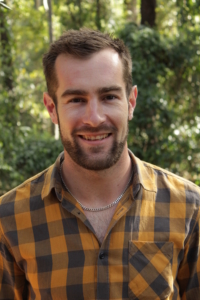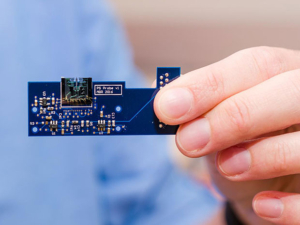Biography
Michael Ruppert received the Dipl.-Ing. Degree in automation technology in production, with a specialization in systems theory and automatic control, from the University of Stuttgart, Germany, in 2013. In 2017, he received the Ph.D. degree with Excellence Award in electrical engineering from The University of Newcastle, Australia where he is now a Postdoctoral Research Fellow with the School of Electrical Engineering and Computing.
Dr Ruppert’s research topics are situated within the area of Micro Precision Mechatronics and as such bridge the gap between classical electrical / control engineering and emerging applications in the field of microelectromechanical systems, high performance microscopy and nanotechnology. His recent work has focused on the development of estimation, control and self-sensing approaches for microelectromechanical (MEMS) systems such as piezoelectric microcantilevers and nanopositioning systems for multifrequency and single-chip atomic force microscopy.
As a Visiting Researcher, he was with the Mechanical Engineering Department, University of Texas at Dallas, USA. During his research visit he worked on the fabrication of piezoelectric microcantilevers in the clean room and lead-authored the publication on the first silicon-on-insulator MEMS on-chip atomic force microscope, recently published and identified as a JMEMS RightNow paper in the IEEE Journal of Microelectromechanical Systems, and which was highlighted in the IEEE Spectrum magazine. During his visit, Dr. Ruppert also consulted to Zyvex LABS, Richardson, USA on the analysis of process stability of scanning tunneling microscope enabled nanolithography.
Dr Ruppert received the Academic Merit Scholarship from the University of Stuttgart, the Baden-Württemberg Scholarship, and held Postgraduate Research Scholarships with the University of Newcastle and with the CSIRO, Clayton, VIC, Australia. Dr Ruppert’s research has been recognized with Best Conference Paper Finalist Awards at the 2018 International Conference on Manipulation, Automation and Robotics at Small Scales (MARSS) and a the 2013 IEEE/ASME International Conference on Advanced Intelligent Mechatronics (AIM). In 2018, the article Multimode Q Control in Tapping-Mode AFM: Enabling Imaging on Higher Flexural Eigenmodes published in IEEE Transactions on Control Systems Technology received the 2018 IEEE TCST Outstanding Paper Award.
Professional Activities
Editorial and Reviewer Roles
- 2020-present: Associate Editor for IEEE Control Systems Letters
- 2020-present: Program Committee for MARSS
- 2018-present: IEEE Control Systems Society Conference Editorial Board: Associate Editor for ACC2019, CDC2019, ACC2020
- 2018-present: Detailed assessor for ARC grant proposals.
- 2013-present: Reviewer for Journals IEEE TNANO, IEEE TMEC, IEEE TCST, IEEE JMEMS, AJC
Organization of Special Session
Theme: Design and Control of Micro and Nano Precision Mechatronic Systems
- July 2019: International Conference on Manipulation, Automation and Robotics at Small Scales (MARSS), Helsinki, Finland
- July 2018: IEEE Advanced Intelligent Mechatronics (AIM), Auckland, New Zealand, 2018
- July 2017: IEEE Advanced Intelligent Mechatronics (AIM), Munich, Germany, 2017
Speaker Invitations
- April 2018: Invited seminars at EPFL, Switzerland and TNO, The Netherlands on ‘Integrated Sensing, Estimation and Control in Multifrequency Atomic Force Microscopy’
- May 2017: IEEE Seminar at University of Western Australia on ‘Self-Sensing, Estimation and Control in Multifrequency Atomic Force Microscopy’
Awards, Prizes and Scholarships
Awards
- 2021 Fresh Scientist, Science in Public
- 2019 Best Conference Paper, IEEE MARSS Conference
- 2018 IEEE TCST Outstanding Paper Award, IEEE Control Systems Society
- 2018 Best Conference Paper Finalist, IEEE MARSS Conference
- 2017 HDR Excellence Award, The University of Newcastle
- 2013 Best Student Conference Paper Finalist, IEEE/ASME AIM International Conference
Prizes
- 2016 FEBE Postgraduate Research Prize, The University of Newcastle
- 2015 Student Paper Competition, Zurich Instruments AG
- 2014 FEBE Postgraduate Research Prize, The University of Newcastle
Publications
2025
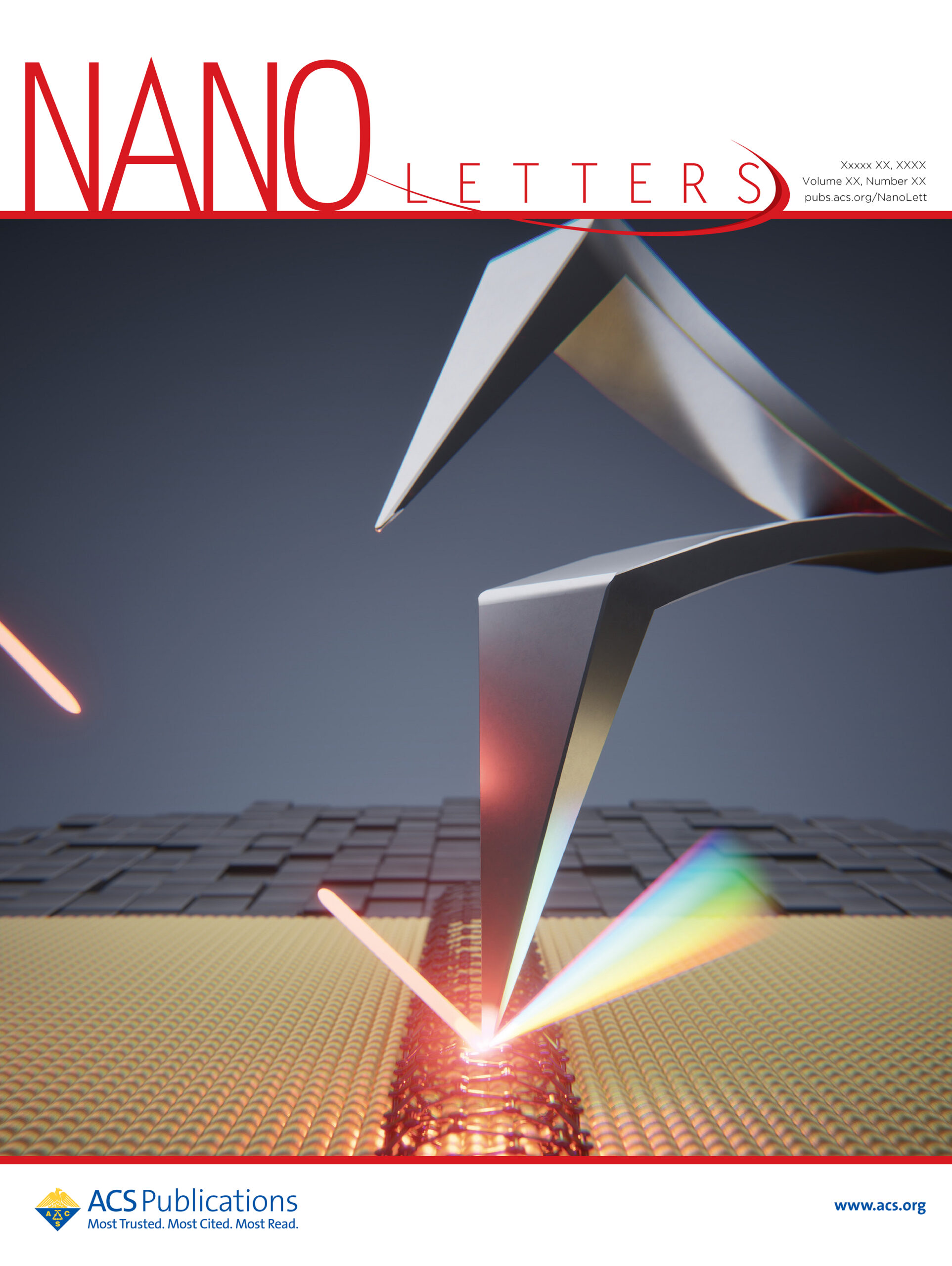
M. G. Ruppert; B. S. Routley; L. R. McCourt; Y. K. Yong; A. J. Fleming
Modulated-Illumination Intermittent-Contact Tip-Enhanced Raman Spectroscopy Journal Article
In: ACS Nano Letters, vol. 25, iss. 14, 2025.
@article{Ruppert2025,
title = {Modulated-Illumination Intermittent-Contact Tip-Enhanced Raman Spectroscopy},
author = {M. G. Ruppert and B. S. Routley and L. R. McCourt and Y. K. Yong and A. J. Fleming},
doi = {https://doi.org/10.1021/acs.nanolett.4c06397},
year = {2025},
date = {2025-03-13},
urldate = {2025-03-13},
journal = {ACS Nano Letters},
volume = {25},
issue = {14},
abstract = {This article presents a proof-of-concept for a new imaging method that combines tip-enhanced Raman spectroscopy with intermittent-contact atomic force microscopy to provide simultaneous nanometer-scale mechanical imaging with chemical contrast. The foremost difference from a standard tip-enhanced Raman microscope is the Raman illumination, which is modulated by the cantilever drive signal so that illumination is only active when the tip is close to the surface. This approach significantly reduces contact forces and thermal damage due to constant illumination while simultaneously reducing background Raman signals. Near-field optical and dynamic cantilever simulations highlight the effect of the imaging parameters on the tip–sample force and the evanescent field enhancement. The experimental images obtained with this new imaging method demonstrate a lateral resolution sufficient to identify single-walled carbon nanotube bundles with a full width at half-maximum of 20 nm.},
keywords = {},
pubstate = {published},
tppubtype = {article}
}
2024
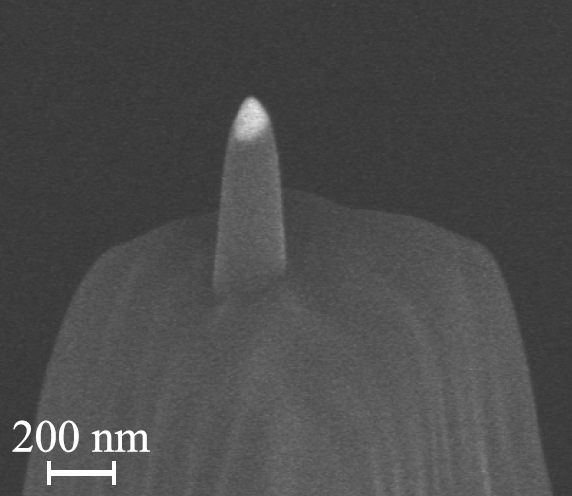
L. R. McCourt; B. S. Routley; M. G. Ruppert; A. J. Fleming
Feasibility of gold nanocones for collocated tip-enhanced Raman spectroscopy and atomic force microscope imaging Journal Article Forthcoming
In: Journal of Raman Spectroscopy, Forthcoming, ISSN: 1097-4555.
@article{J23a,
title = {Feasibility of gold nanocones for collocated tip-enhanced Raman spectroscopy and atomic force microscope imaging },
author = {L. R. McCourt and B. S. Routley and M. G. Ruppert and A. J. Fleming},
url = {https://www.precisionmechatronicslab.com/wp-content/uploads/2024/02/J23a-Preprint.pdf},
doi = {10.1002/jrs.6625},
issn = {1097-4555},
year = {2024},
date = {2024-02-01},
urldate = {2024-02-01},
journal = {Journal of Raman Spectroscopy},
abstract = {Microcantilever probes for tip-enhanced Raman spectroscopy (TERS) have a grainy metal coating that may exhibit multiple plasmon hotspots near the tip apex, which may compromise spatial resolution and introduce imaging artefacts. It is also possible that the optical hotspot may not occur at the mechanical apex, which introduces an offset between TERS and atomic force microscope maps. In this article, a gold nanocone TERS probe is designed and fabricated for 638 nm excitation. The imaging performance is compared to grainy probes by analysing high-resolution TERS cross-sections of single-walled carbon nanotubes. Compared to the tested conventional TERS probes, the nanocone probe exhibited a narrow spot diameter, comparable optical contrast, artefact-free images, and collocation of TERS and atomic force microscope topographic maps. The spot diameter was 12.5 nm and 19 nm with 638 nm and 785 nm excitation, respectively. These results were acquired using a single gold nanocone probe to experimentally confirm feasibility. Future work will include automating the fabrication process and statistical analysis of many probes.},
keywords = {},
pubstate = {forthcoming},
tppubtype = {article}
}
2022
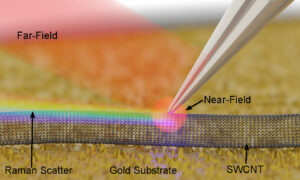
L. R. McCourt; B. S. Routley; M. G. Ruppert; V. J. Keast; C. I. Sathish; R. Borah; R. V. Goreham; A. J. Fleming
In: ACS Applied Nano Materials, vol. 5, iss. 7, pp. 9024-9033, 2022, ISSN: 2574-0970.
@article{nokey,
title = {Single-Walled Carbon Nanotubes as One-Dimensional Scattering Surfaces for Measuring Point Spread Functions and Performance of Tip-Enhanced Raman Spectroscopy Probes},
author = {L. R. McCourt and B. S. Routley and M. G. Ruppert and V. J. Keast and C. I. Sathish and R. Borah and R. V. Goreham and A. J. Fleming},
url = {https://www.precisionmechatronicslab.com/wp-content/uploads/2023/02/J22i.pdf},
doi = {10.1021/acsanm.2c01274},
issn = {2574-0970},
year = {2022},
date = {2022-06-21},
urldate = {2022-06-21},
journal = {ACS Applied Nano Materials},
volume = {5},
issue = {7},
pages = {9024-9033},
abstract = {This Article describes a method for the characterization of the imaging performance of tip-enhanced Raman spectroscopy probes. The proposed method identifies single-walled carbon nanotubes that are suitable as one-dimensional Raman scattering objects by using atomic force microscope maps and exciting the radial breathing mode using 785 nm illumination. High-resolution cross sections of the nanotubes are collected, and the point spread functions are calculated along with the optical contrast and spot diameter. The method is used to characterize several probes, which results in a set of imaging recommendations and a summary of limitations for each probe. Elemental analysis and boundary element simulations are used to explain the formation of multiple peaks in the point spread functions as a consequence of random grain formation on the probe surface.},
keywords = {},
pubstate = {published},
tppubtype = {article}
}
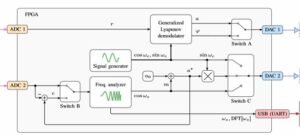
M. R. P. Ragazzon; S. Messineo; J. T. Gravdahl; D. M. Harcombe; M. G. Ruppert
The Generalized Lyapunov Demodulator: High-Bandwidth, Low-Noise Amplitude and Phase Estimation Journal Article
In: IEEE Open Journal of Control Systems, 2022.
@article{Ragazzon2022,
title = {The Generalized Lyapunov Demodulator: High-Bandwidth, Low-Noise Amplitude and Phase Estimation},
author = {M. R. P. Ragazzon and S. Messineo and J. T. Gravdahl and D. M. Harcombe and M. G. Ruppert},
doi = {10.1109/OJCSYS.2022.3181111},
year = {2022},
date = {2022-06-08},
urldate = {2022-06-08},
journal = {IEEE Open Journal of Control Systems},
abstract = {Effective demodulation of amplitude and phase is a requirement in a wide array of applications. Recent efforts have increased the demodulation performance, in particular, the Lyapunov demodulator allows bandwidths up to the carrier frequency of the signal. However, being inherently restricted to first-order filtering of the input signal, it is highly sensitive to frequency components outside its passband region. This makes it unsuitable for certain applications such as multifrequency atomic force microscopy (AFM). In this article, the structure of the Lyapunov demodulator is transformed to an equivalent form and generalized by exploiting the internal model principle. The resulting generalized Lyapunov demodulator structure allows for arbitrary filtering order and is easy to implement, requiring only a bandpass filter, a single integrator, and two nonlinear transformations. The generalized Lyapunov demodulator is implemented experimentally on a field-programmable gate array (FPGA). Then it is used for imaging in an AFM and benchmarked against the standard Lyapunov demodulator and the widely used lock-in amplifier. The lock-in amplifier achieves great noise attenuation capabilities and off-mode rejection at low bandwidths, whereas the standard Lyapunov demodulator is shown to be effective at high bandwidths. We demonstrate that the proposed demodulator combines the best from the two state-of-the-art demodulators, demonstrating high bandwidths, large off-mode rejection, and excellent noise attenuation simultaneously.},
keywords = {},
pubstate = {published},
tppubtype = {article}
}
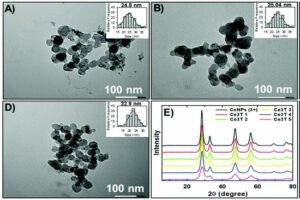
N. Yadav; V. Patel; L. McCourt; M. G. Ruppert; M. Miller; T. Inerbaev; S. Mahasivam; V. Bansal; A. Vinu; S. Singh; A. Karakoti
Tuning the enzyme-like activities of cerium oxide nanoparticles using a triethyl phosphite ligand Journal Article
In: Royal Society of Chemistry: Biomaterials Science, 2022.
@article{nokey,
title = {Tuning the enzyme-like activities of cerium oxide nanoparticles using a triethyl phosphite ligand},
author = {N. Yadav and V. Patel and L. McCourt and M. G. Ruppert and M. Miller and T. Inerbaev and S. Mahasivam and V. Bansal and A. Vinu and S. Singh and A. Karakoti},
doi = {10.1039/d2bm00396a},
year = {2022},
date = {2022-04-22},
journal = {Royal Society of Chemistry: Biomaterials Science},
abstract = {Cerium oxide nanoparticles (CeNPs) exhibit excellent in vitro and in vivo antioxidant properties, determined by the redox switching of surface cerium ions between their two oxidation states (Ce3+ and Ce4+). It is known that ligands such as triethyl phosphite (TEP) can tune the redox behavior of CeNPs and change their biological enzyme-mimetic activities; however, the corresponding mechanism for such a behavior is completely unknown. Herein, we have studied the effect of TEP in promoting the SOD-enzyme-like activity in CeNPs with high and low Ce3+/Ce4+ ratio, which were synthesized by wet chemical and thermal hydrolysis methods, respectively, and incubated with varying concentrations of TEP. X-ray diffraction, UV-visible, photoluminescence, X-ray photoelectron spectroscopy, and Raman spectroscopy combined with DFT calculations were used to investigate the interaction of TEP on the surface of CeNPs. We observed a clear correlation between TEP concentration and the formation of surface oxygen vacancies. XPS analysis confirmed the increase in Ce3+ concentration after interaction with TEP. Moreover, we show that TEP's influence depends on the surface Ce3+/Ce4+ ratio. The superoxide dismutase-, catalase-, and oxidase-like activities of CeNPs with high Ce3+/Ce4+ ratio are not affected by TEP interaction, whereas catalase- and oxidase-like activities of CeNPs with low Ce3+/Ce4+ ratio decrease and the SOD-like activity is found to increase upon incubation with different concentrations of TEP. We also demonstrate that TEP interaction does not affect the regeneration of the CeNP surface, while the DFT calculations show that TEP facilitates the formation of defects on the surface of stoichiometric cerium oxide by reducing the oxygen vacancy formation energy. CeNPs with low Ce3+/Ce4+ ratio incubated with TEP also exhibited good antibacterial activity as compared to the CeNPs or TEP alone.},
keywords = {},
pubstate = {published},
tppubtype = {article}
}
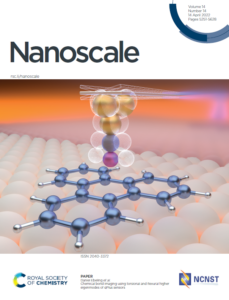
D. Martin-Jimenez; M. G. Ruppert; A. Ihle; S. Ahles; H. A. Wegner; A. Schirmeisen; D. Ebeling
Chemical bond imaging using torsional and flexural higher eigenmodes of qPlus sensors Journal Article
In: Nanoscale - The Royal Society of Chemistry, vol. 14, no. 14, pp. 5251-5628, 2022.
@article{nokey,
title = {Chemical bond imaging using torsional and flexural higher eigenmodes of qPlus sensors},
author = {D. Martin-Jimenez and M. G. Ruppert and A. Ihle and S. Ahles and H. A. Wegner and A. Schirmeisen and D. Ebeling},
url = {https://www.precisionmechatronicslab.com/wp-content/uploads/2022/04/Nanoscale-2022-Martin-Jimenez-bond-imaging-with-torsional-and-flexural-higher-eigenmodes.pdf},
doi = {10.1039/d2nr01062c},
year = {2022},
date = {2022-03-23},
urldate = {2022-03-23},
journal = {Nanoscale - The Royal Society of Chemistry},
volume = {14},
number = {14},
pages = {5251-5628},
abstract = {Non-contact atomic force microscopy (AFM) with CO-functionalized tips allows to visualize the chemical structure of adsorbed molecules and identify individual inter- and intramolecular bonds. This technique enables in-depth studies of on-surface reactions and self-assembly processes. Herein, we analyze the suitability of qPlus sensors, which are commonly used for such studies, for the application of modern multifrequency AFM techniques. Two different qPlus sensors were tested for submolecular resolution imaging via actuating torsional and flexural higher eigenmodes and via bimodal AFM. The torsional eigenmode of one of our sensors is perfectly suited for performing lateral force microscopy (LFM) with single bond resolution. The obtained LFM images agree well with images from the literature, which were scanned with customized qPlus sensors that were specifically designed for LFM. The advantage of using a torsional eigenmode is that the same molecule can be imaged either with a vertically or laterally oscillating tip without replacing the sensor simply by actuating a different eigenmode. Submolecular resolution is also achieved by actuating the 2nd flexural eigenmode of our second sensor. In this case, we observe particular contrast features that only appear in the AFM images of the 2nd flexural eigenmode but not for the fundamental eigenmode. With complementary laser Doppler vibrometry measurements and AFM simulations we can rationalize that these contrast features are caused by a diagonal (i.e. in-phase vertical and lateral) oscillation of the AFM tip.},
keywords = {},
pubstate = {published},
tppubtype = {article}
}
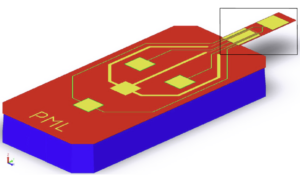
N. F. S. de Bem; M. G. Ruppert; A. J. Fleming; Y. K. Yong
In: Sensors and Actuators A: Physical, vol. 338, pp. 113496, 2022, ISSN: 0924-4247, (This work was supported by the Australian Research Council Discovery Project DP170101813).
@article{J22a,
title = {Simultaneous tip force and displacement sensing for AFM cantilevers with on-chip actuation: Design and characterization for off-resonance tapping mode},
author = {N. F. S. de Bem and M. G. Ruppert and A. J. Fleming and Y. K. Yong},
url = {https://www.precisionmechatronicslab.com/wp-content/uploads/2022/03/J22a.pdf},
doi = {10.1016/j.sna.2022.113496},
issn = {0924-4247},
year = {2022},
date = {2022-03-08},
urldate = {2022-03-08},
journal = {Sensors and Actuators A: Physical},
volume = {338},
pages = {113496},
abstract = {The use of integrated on-chip actuation simplifies the identification of a cantilever resonance, can improve imaging speed, and enables the use of smaller cantilevers, which is required for low-force imaging at high speed. This article describes a cantilever with on-chip actuation and novel dual-sensing capabilities for AFM. The dual-sensing configuration allows for tip displacement and tip force to be measured simultaneously. A mathematical model is developed and validated with finite element analysis. A physical prototype is presented, and its calibration and validation are presented. The cantilever is optimized for use in off-resonance tapping modes. Experimental results demonstrate an agreement between the on-chip sensors and external force and displacement measurements.},
note = {This work was supported by the Australian Research Council Discovery Project DP170101813},
keywords = {},
pubstate = {published},
tppubtype = {article}
}
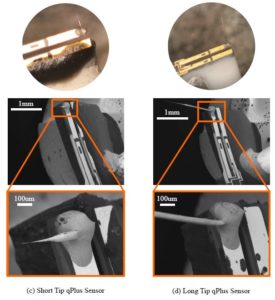
M. G. Ruppert; D. Martin-Jimenez; Y. K. Yong; A. Ihle; A. Schirmeisen; A. J. Fleming; D. Ebeling
Experimental Analysis of Tip Vibrations at Higher Eigenmodes of QPlus Sensors for Atomic Force Microscopy Journal Article
In: Nanotechnology, vol. 33, iss. 18, pp. 185503, 2022, ISSN: 1361-6528, (This work was supported in part by the Australian Research Council Discovery Project DP170101813).
@article{Ruppert2022,
title = {Experimental Analysis of Tip Vibrations at Higher Eigenmodes of QPlus Sensors for Atomic Force Microscopy},
author = {M. G. Ruppert and D. Martin-Jimenez and Y. K. Yong and A. Ihle and A. Schirmeisen and A. J. Fleming and D. Ebeling},
url = {https://www.precisionmechatronicslab.com/wp-content/uploads/2022/03/J22c.pdf},
doi = {10.1088/1361-6528/ac4759},
issn = {1361-6528},
year = {2022},
date = {2022-02-10},
urldate = {2022-02-10},
journal = {Nanotechnology},
volume = {33},
issue = {18},
pages = {185503},
abstract = {QPlus sensors are non-contact atomic force microscope probes constructed from a quartz tuning fork and a tungsten wire with an electrochemically etched tip. These probes are self-sensing and offer an atomic-scale spatial resolution. Therefore, qPlus sensors are routinely used to visualize the chemical structure of adsorbed organic molecules via the so-called bond imaging technique. This is achieved by functionalizing the AFM tip with a single CO molecule and exciting the sensor at the first vertical cantilever resonance mode. Recent work using higher-order resonance modes has also resolved the chemical structure of single organic molecules. However, in these experiments, the image contrast can differ significantly from the conventional bond imaging contrast, which was suspected to be caused by unknown vibrations of the tip. This work investigates the source of these artefacts by using a combination of mechanical simulation and laser vibrometry to characterize a range of sensors with different tip wire geometries. The results show that increased tip mass and length cause increased torsional rotation of the tuning fork beam due to the off-center mounting of the tip wire, and increased flexural vibration of the tip. These undesirable motions cause lateral deflection of the probe tip as it approaches the sample, which is rationalized to be the cause of the different image contrast. The results also provide a guide for future probe development to reduce these issues.},
note = {This work was supported in part by the Australian Research Council Discovery Project DP170101813},
keywords = {},
pubstate = {published},
tppubtype = {article}
}
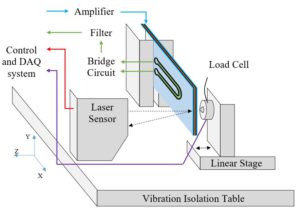
R. Seethaler; S. Z. Mansour; M. G. Ruppert; A. J. Fleming
Piezoelectric Benders with Strain Sensing Electrodes: Sensor Design for Position Control and Force Estimation Journal Article
In: Sensors and Actuators A: Physical, vol. 335, pp. 113384, 2022, ISSN: 0924-4247.
@article{Fleming2022,
title = {Piezoelectric Benders with Strain Sensing Electrodes: Sensor Design for Position Control and Force Estimation},
author = {R. Seethaler and S. Z. Mansour and M. G. Ruppert and A. J. Fleming},
url = {https://www.precisionmechatronicslab.com/wp-content/uploads/2022/03/J22b.pdf},
doi = {https://doi.org/10.1016/j.sna.2022.113384},
issn = {0924-4247},
year = {2022},
date = {2022-01-22},
urldate = {2022-01-22},
journal = {Sensors and Actuators A: Physical},
volume = {335},
pages = {113384},
abstract = {Piezoelectric benders are widely used in industrial applications due to their low-cost and compact size. However, due to the large relative size and cost of displacement sensors, bender actuators are often operated in open-loop or with feed-forward control, which can limit positioning accuracy to 20% of full-scale. To improve the positioning accuracy of piezoelectric benders, this article proposes integrating resistive strain gauges into the electrode surface by chemical etching or laser ablation. These strain sensors are then used to measure and control the tip displacement. The proposed sensors are shown to suffer from significant cross-coupling between the actuator voltage and measured signal; however, this can be mitigated by judicious choice of the sensor location and actuator driving scheme. In addition to position sensing, a method is also presented for simultaneous estimation of the contact force between the actuator tip and load. The proposed methods are validated experimentally by controlling the tip position of a piezoelectric bender while simultaneously estimating the force applied to a reference load cell.},
keywords = {},
pubstate = {published},
tppubtype = {article}
}
2021
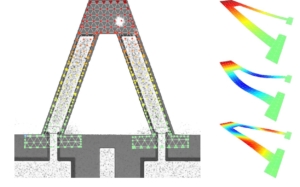
M. G. Ruppert; N. F. S. de Bem; A. J. Fleming; Y. K. Yong
Characterization of Active Microcantilevers Using Laser Doppler Vibrometry Book Chapter
In: Vibration Engineering for a Sustainable Future , Chapter 45, Springer, 2021, ISBN: 978-3-030-48153-7, (This work was supported by the Australian Research Council Discovery Project DP170101813).
@inbook{Ruppert2021b,
title = {Characterization of Active Microcantilevers Using Laser Doppler Vibrometry},
author = {M. G. Ruppert and N. F. S. de Bem and A. J. Fleming and Y. K. Yong},
url = {https://www.precisionmechatronicslab.com/wp-content/uploads/2022/03/BC21a.pdf},
doi = {10.1007/978-3-030-48153-7},
isbn = {978-3-030-48153-7},
year = {2021},
date = {2021-06-18},
urldate = {2021-06-18},
booktitle = {Vibration Engineering for a Sustainable Future
},
issuetitle = {Experiments, Materials and Signal Processing, Vol. 2},
publisher = {Springer},
chapter = {45},
abstract = {Active atomic force microscope cantilevers with on-chip actuation and sensing provide several advantages over passive cantilevers which rely on piezoacoustic base-excitation and the optical beam deflection measurement. Most importantly, these cantilevers provide clean frequency responses, the possibility of down-scaling and parallelization to cantilever arrays as well as the absence of optical interferences. In this paper, we demonstrate the analysis and calibration steps for three active cantilever geometries with integrated piezoelectric actuation. For this purpose, laser Doppler vibrometry (LDV) is used to experimentally obtain the deflection mode shapes of the first three eigenmodes, calibrate actuation gains, and to determine the dynamic modal stiffnesses using the Brownian spectrum of the cantilever. The experimental values are compared with finite element simulations.},
note = {This work was supported by the Australian Research Council Discovery Project DP170101813},
keywords = {},
pubstate = {published},
tppubtype = {inbook}
}
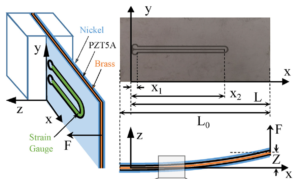
R. Seethaler; S. Z. Mansour; M. G. Ruppert; A. J. Fleming
Position and force sensing using strain gauges integrated into piezoelectric bender electrodes Journal Article
In: Sensors and Actuators A: Physical, vol. 321, pp. 112416, 2021, ISBN: 0924-4247.
@article{J21e,
title = {Position and force sensing using strain gauges integrated into piezoelectric bender electrodes},
author = {R. Seethaler and S. Z. Mansour and M. G. Ruppert and A. J. Fleming},
url = {https://www.precisionmechatronicslab.com/wp-content/uploads/2022/03/J21e-1.pdf},
doi = {10.1016/j.sna.2020.112416},
isbn = {0924-4247},
year = {2021},
date = {2021-04-15},
urldate = {2020-12-30},
journal = {Sensors and Actuators A: Physical},
volume = {321},
pages = {112416},
abstract = {This article derives design guidelines for integrating strain gauges into the electrodes of piezoelectric bending actuators. The proposed sensor can estimate the actuator tip displacement in response to an applied voltage and an external applied tip force. The actuator load force is also estimated with an accuracy of 8% full scale by approximating the actuator response with a linear model. The applications of this work include micro-grippers and pneumatic valves, which both require the measurement of deflection and load force. At present, this is achieved by external sensors. However, this work shows that these functions can be integrated into the actuator electrodes.},
keywords = {},
pubstate = {published},
tppubtype = {article}
}
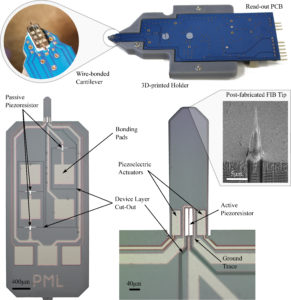
M. G. Ruppert; A. J. Fleming; Y. K. Yong
Active atomic force microscope cantilevers with integrated device layer piezoresistive sensors Journal Article
In: Sensors & Actuators: A. Physical, vol. 319, pp. 112519, 2021, ISSN: 0924-4247, (This work was supported by the Australian Research Council Discovery Project DP170101813).
@article{Ruppert2021,
title = {Active atomic force microscope cantilevers with integrated device layer piezoresistive sensors},
author = {M. G. Ruppert and A. J. Fleming and Y. K. Yong},
url = {https://www.precisionmechatronicslab.com/wp-content/uploads/2021/01/J21a.pdf},
doi = {10.1016/j.sna.2020.112519},
issn = {0924-4247},
year = {2021},
date = {2021-01-19},
urldate = {2021-01-19},
journal = {Sensors & Actuators: A. Physical},
volume = {319},
pages = {112519},
abstract = {Active atomic force microscope cantilevers with on-chip actuation and sensing provide several advantages over
passive cantilevers which rely on piezoacoustic base-excitation and optical beam deflection measurement. Active
microcantilevers exhibit a clean frequency response, provide a path-way to miniturization and parallelization and
avoid the need for optical alignment. However, active microcantilevers are presently limited by the feedthrough
between actuators and sensors, and by the cost associated with custom microfabrication. In this work, we propose
a hybrid cantilever design with integrated piezoelectric actuators and a piezoresistive sensor fabricated from the
silicon device layer without requiring an additional doping step. As a result, the design can be fabricated using a
commercial five-mask microelectromechanical systems fabrication process. The theoretical piezoresistor sensitivity
is compared with finite element simulations and experimental results obtained from a prototype device. The
proposed approach is demonstrated to be a promising alternative to conventional microcantilever actuation and
deflection sensing},
note = {This work was supported by the Australian Research Council Discovery Project DP170101813},
keywords = {},
pubstate = {published},
tppubtype = {article}
}
passive cantilevers which rely on piezoacoustic base-excitation and optical beam deflection measurement. Active
microcantilevers exhibit a clean frequency response, provide a path-way to miniturization and parallelization and
avoid the need for optical alignment. However, active microcantilevers are presently limited by the feedthrough
between actuators and sensors, and by the cost associated with custom microfabrication. In this work, we propose
a hybrid cantilever design with integrated piezoelectric actuators and a piezoresistive sensor fabricated from the
silicon device layer without requiring an additional doping step. As a result, the design can be fabricated using a
commercial five-mask microelectromechanical systems fabrication process. The theoretical piezoresistor sensitivity
is compared with finite element simulations and experimental results obtained from a prototype device. The
proposed approach is demonstrated to be a promising alternative to conventional microcantilever actuation and
deflection sensing
2020
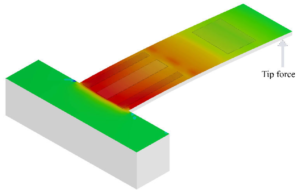
N. F. S. de Bem; M. G. Ruppert; Y. K. Yong; A. J. Fleming
Integrated force and displacement sensing in active microcantilevers for off-resonance tapping mode atomic force microscopy Proceedings Article
In: International Conference on Manipulation, Automation and Robotics at Small Scales (MARSS), pp. 1-6, 2020, (This work was supported by the Australian Research Council Discovery Project DP170101813).
@inproceedings{C20c,
title = {Integrated force and displacement sensing in active microcantilevers for off-resonance tapping mode atomic force microscopy},
author = {N. F. S. de Bem and M. G. Ruppert and Y. K. Yong and A. J. Fleming},
url = {https://www.precisionmechatronicslab.com/wp-content/uploads/2021/01/C20c.pdf},
doi = {10.1109/MARSS49294.2020.9307881},
year = {2020},
date = {2020-11-30},
urldate = {2020-11-30},
booktitle = {International Conference on Manipulation, Automation and Robotics at Small Scales (MARSS)},
pages = {1-6},
abstract = {Integrated on-chip actuation and sensing in microcantilevers for atomic force microscopy (AFM) allows faster scanning speeds, cleaner frequency responses and smaller cantilevers. However, a single integrated sensor suffers from crosscoupling between displacements originating from tip-sample forces and direct actuation. This paper addresses this issue by presenting a novel microcantilever with on-chip actuation and integrated dual sensing for AFM with application to offresonance tapping modes in AFM. The proposed system is able to measure tip force and deflection simultaneously. A mathematical model is developed for a rectangular cantilever to describe the system and is validated with finite element analysis.},
note = {This work was supported by the Australian Research Council Discovery Project DP170101813},
keywords = {},
pubstate = {published},
tppubtype = {inproceedings}
}
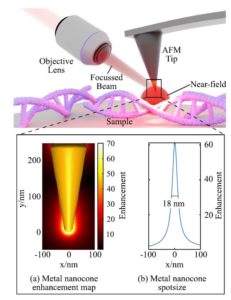
L. McCourt; M. G. Ruppert; B. S. Routley; S. Indirathankam; A. J. Fleming
A comparison of gold and silver nanocones and geometry optimisation for tip-enhanced microscopy Journal Article
In: Journal of Raman Spectroscopy, vol. 51, iss. 11, pp. 2208-2216, 2020.
@article{McCourt2020,
title = {A comparison of gold and silver nanocones and geometry optimisation for tip-enhanced microscopy},
author = {L. McCourt and M. G. Ruppert and B. S. Routley and S. Indirathankam and A. J. Fleming},
url = {https://www.precisionmechatronicslab.com/wp-content/uploads/2020/09/J20e.pdf},
doi = {https://doi.org/10.1002/jrs.5987},
year = {2020},
date = {2020-11-01},
urldate = {2020-08-24},
journal = {Journal of Raman Spectroscopy},
volume = {51},
issue = {11},
pages = {2208-2216},
abstract = {In this article, boundary element method simulations are used to optimise the geometry of silver and gold nanocone probes to maximise the localised electric field enhancement and tune the near-field resonance wavelength. These objectives are expected to maximise the sensitivity of tip-enhanced Raman microscopes. Similar studies have used limited parameter sets or used a performance metric other than localised electric field enhancement. In this article, the optical responses for a range of nanocone geometries are simulated for excitation wavelengths ranging from 400 to 1000 nm. Performance is evaluated by measuring the electric field enhancement at the sample surface with a resonant illumination wavelength. These results are then used to determine empirical models and derive optimal nanocone geometries for a particular illumination wavelength and tip material. This article concludes that gold nanocones are expected to provide similar performance to silver nanocones at red and nearinfrared wavelengths, which is consistent with other results in the literature. In this article, 633 nm is determined to be the shortest usable illumination wavelength for gold nanocones. Below this limit, silver nanocones will provide superior enhancement. The use of gold nanocone probes is expected to dramatically improve probe lifetime, which is currently measured in hours for silver coated probes. Furthermore, the elimination of passivation coatings is expected to enable smaller probe radii and improved topographical resolution.},
keywords = {},
pubstate = {published},
tppubtype = {article}
}
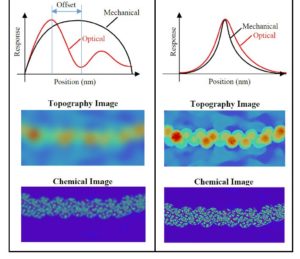
A. J. Fleming; M. G. Ruppert; B. S. Routley; L. McCourt
Overcoming the Limitations of Tip Enhanced Raman Spectroscopy with Intermittent Contact AFM Conference
8th Multifrequency AFM Conference, Madrid, Spain, 2020.
@conference{Fleming2020,
title = {Overcoming the Limitations of Tip Enhanced Raman Spectroscopy with Intermittent Contact AFM},
author = {A. J. Fleming and M. G. Ruppert and B. S. Routley and L. McCourt},
year = {2020},
date = {2020-10-27},
booktitle = {8th Multifrequency AFM Conference},
address = {Madrid, Spain},
abstract = {Tip enhanced Raman spectroscopy (TERS) is a promising technique for mapping the chemical composition of surfaces with molecular scale. However, current TERS methods are limited by a number of issues including high tip-sample forces, high laser power, low topographical resolution, and short probe lifetime. As a result, TERS methods are best suited to robust samples that can tolerate high optical intensity. To overcome these issues and extend the application of TERS to delicate samples, a number of new probes andimaging modes are in development at the University of Newcastle. This talk will provide an overview of these methods and present preliminary results, including new methods for optical probe optimization and fabrication, and a new dynamic-mode AFM method to reduce contact forces and applied laser power.},
keywords = {},
pubstate = {published},
tppubtype = {conference}
}
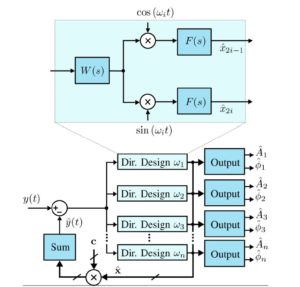
M. G. Ruppert; D. M. Harcombe; A. J. Fleming
Traditional and Novel Demodulators for Multifrequency Atomic Force Microscopy Conference
8th Multifrequency AFM Conference, Madrid, Spain, 2020.
@conference{Ruppert2020b,
title = {Traditional and Novel Demodulators for Multifrequency Atomic Force Microscopy},
author = {M. G. Ruppert and D. M. Harcombe and A. J. Fleming},
year = {2020},
date = {2020-10-27},
booktitle = {8th Multifrequency AFM Conference},
address = {Madrid, Spain},
abstract = {A number of multifrequency atomic force microscopy (MF-AFM) methods make use of the excitation and detection of higher harmonics of the fundamental frequency, higher flexural eigenmodes or intermodulation products generated by the non-linear tip-sample force [1]. Schematically, these methods are depicted in Figure 1(a) where the main difference is the resulting spacing and amplitude of the frequency components in the generated spectrum shown in Figure 1(b). Regardless of which particular MF-AFM method is employed, each requires a demodulator to obtain amplitude and phase to form observables for the characterization of nanomechanical sample information. Since high-speed non-synchronous demodulators such as the peak-hold method, peak detector and RMS-to-DC converter are incompatible with MF-AFM [2], there is a need for high-bandwidth demodulation techniques capable of estimating multiple frequencies at once while maintaining robustness against unwanted frequency components [3]. In this talk, the performance of traditional and recently proposed demodulators for multifrequency atomic force microscopy is assessed experimentally. The compared methods include the lock-in amplifier, coherent demodulator, Kalman filter, Lyapunov filter, and direct-design demodulator. Each method is implemented on a field-programmable gate array (FPGA) with a sampling rate of 1.5 MHz. The metrics for comparison include implementation complexity, the sensitivity to other frequency components and the magnitude of demodulation artifacts for a range of demodulator bandwidths. Performance differences are demonstrated through higher harmonic atomic force microscopy imaging.},
keywords = {},
pubstate = {published},
tppubtype = {conference}
}
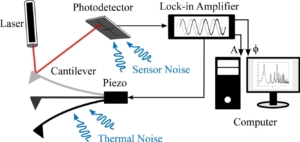
M. G. Ruppert; N. J. Bartlett; Y. K. Yong; A. J. Fleming
Amplitude Noise Spectrum of a Lock-in Amplifier: Application to Microcantilever Noise Measurements Journal Article
In: Sensors and Actuators A: Physical, vol. 312, pp. 112092, 2020, (This work was supported by the Australian Research Council Discovery Project DP170101813).
@article{Ruppert2020,
title = {Amplitude Noise Spectrum of a Lock-in Amplifier: Application to Microcantilever Noise Measurements},
author = {M. G. Ruppert and N. J. Bartlett and Y. K. Yong and A. J. Fleming},
url = {https://www.precisionmechatronicslab.com/wp-content/uploads/2020/09/J20f.pdf},
doi = {10.1016/j.sna.2020.112092},
year = {2020},
date = {2020-05-29},
urldate = {2020-05-29},
journal = {Sensors and Actuators A: Physical},
volume = {312},
pages = {112092},
abstract = {The lock-in amplifier is a crucial component in many applications requiring high-resolution displacement sensing; it's purpose is to estimate the amplitude and phase of a periodic signal, potentially corrupted by noise, at a frequency determined by a reference signal. Where the noise can be approximated by a stationary Gaussian process, such as thermal force noise and electronic sensor noise, this article derives the amplitude noise spectral density of the lock-in-amplifier output. The proposed method is demonstrated by predicting the demodulated noise spectrum of a microcantilever for dynamic-mode atomic force microscopy to determine the cantilever on-resonance thermal noise, the cantilever tracking bandwidth and the electronic noise floor. The estimates are shown to closely match experimental results over a wide range of operating conditions.},
note = {This work was supported by the Australian Research Council Discovery Project DP170101813},
keywords = {},
pubstate = {published},
tppubtype = {article}
}
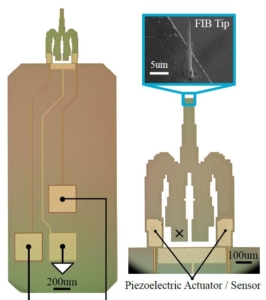
S. I. Moore; M. G. Ruppert; Y. K. Yong
AFM Cantilever Design for Multimode Q Control: Arbitrary Placement of Higher-Order Modes Journal Article
In: IEEE/ASME Transactions on Mechatronics, pp. 1-6, 2020, (This work was supported by the Australian Research Council Discovery Project DP170101813).
@article{Moore2020,
title = {AFM Cantilever Design for Multimode Q Control: Arbitrary Placement of Higher-Order Modes},
author = {S. I. Moore and M. G. Ruppert and Y. K. Yong},
url = {https://ieeexplore.ieee.org/document/9006926},
doi = {10.1109/TMECH.2020.2975627},
year = {2020},
date = {2020-02-21},
urldate = {2020-02-21},
journal = { IEEE/ASME Transactions on Mechatronics},
pages = {1-6},
abstract = {In the fast growing field of multifrequency atomic force microscopy (AFM), the benefits of using higher-order modes has been extensively reported on. However, higher modes of AFM cantilevers are difficult to instrument and Q control is challenging owing to their high frequency nature. At these high frequencies, the latencies in the computations and analog conversions of digital signal processing platforms become significant and limit the effective bandwidth of digital feedback controller implementations. To address this issue, this article presents a novel cantilever design for which the first five modes are placed within a 200 kHz bandwidth. The proposed cantilever is designed using a structural optimization routine. The close spacing and low mechanical bandwidth of the resulting cantilever allows for the implementation of Q controllers for all five modes using a standard FPGA development board for bimodal AFM and imaging on higher-order modes.},
note = {This work was supported by the Australian Research Council Discovery Project DP170101813},
keywords = {},
pubstate = {published},
tppubtype = {article}
}
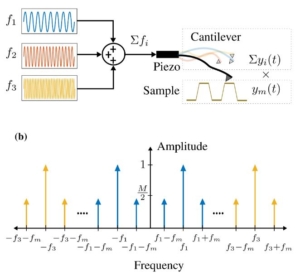
D. M. Harcombe; M. G. Ruppert; A. J. Fleming
A review of demodulation techniques for multifrequency atomic force microscopy Journal Article
In: Beilstein Journal of Nanotechnology, vol. 11, pp. 76-97, 2020, ISSN: 21904286.
@article{Harcombe2020,
title = {A review of demodulation techniques for multifrequency atomic force microscopy},
author = {D. M. Harcombe and M. G. Ruppert and A. J. Fleming},
editor = {T. Glatzel},
url = {https://www.precisionmechatronicslab.com/wp-content/uploads/2020/02/J20b-reducedSize.pdf},
doi = {doi:10.3762/bjnano.11.8},
issn = {21904286},
year = {2020},
date = {2020-01-07},
journal = {Beilstein Journal of Nanotechnology},
volume = {11},
pages = {76-97},
abstract = {This article compares the performance of traditional and recently proposed demodulators for multifrequency atomic force microscopy. The compared methods include the lock-in amplifier, coherent demodulator, Kalman filter, Lyapunov filter, and direct-design demodulator. Each method is implemented on a field-programmable gate array (FPGA) with a sampling rate of 1.5 MHz. The metrics for comparison include the sensitivity to other frequency components and the magnitude of demodulation artifacts for a range of demodulator bandwidths. Performance differences are demonstrated through higher harmonic atomic force microscopy imaging.},
keywords = {},
pubstate = {published},
tppubtype = {article}
}
2019
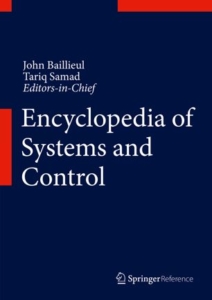
M. G. Ruppert; S. O. R. Moheimani
Dynamics and Control of Active Microcantilevers Book Chapter
In: Baillieul, John; Samad, Tariq (Ed.): Encyclopedia of Systems and Control, vol. 2, Springer London, 2019, ISBN: 978-1-4471-5102-9.
@inbook{Ruppert2019b,
title = {Dynamics and Control of Active Microcantilevers},
author = {M. G. Ruppert and S. O. R. Moheimani},
editor = {Baillieul, John and Samad, Tariq},
url = {https://rd.springer.com/referenceworkentry/10.1007%2F978-1-4471-5102-9_184-2},
doi = {10.1007/978-1-4471-5102-9_184-2},
isbn = {978-1-4471-5102-9},
year = {2019},
date = {2019-11-16},
booktitle = {Encyclopedia of Systems and Control},
volume = {2},
publisher = {Springer London},
abstract = {The microcantilever is a key precision mechatronic component of many technologies for characterization and manipulation of matter at the nanoscale, particularly in the atomic force microscope. When a cantilever is operated in a regime that requires the direct excitation and measurement of its resonance frequencies, appropriate instrumentation and control is crucial for high-performance operation. In this entry, we discuss integrated cantilever actuation and present the cantilever transfer function model and its properties. As a result of using these active cantilevers, the ability to control the quality factor in order to manipulate the cantilever tracking bandwidth is demonstrated.},
keywords = {},
pubstate = {published},
tppubtype = {inbook}
}
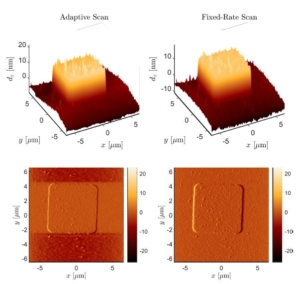
K. Wang; M. G. Ruppert; C. Manzie; D. Nesic; Y. K. Yong
Scan Rate Adaptation for AFM Imaging Based on Performance Metric Optimisation Journal Article
In: IEEE/ASME Transactions on Mechatronics, 2019, (early access).
@article{Wang2019b,
title = {Scan Rate Adaptation for AFM Imaging Based on Performance Metric Optimisation},
author = {K. Wang and M. G. Ruppert and C. Manzie and D. Nesic and Y. K. Yong },
url = {https://ieeexplore.ieee.org/document/8867937},
doi = {10.1109/TMECH.2019.2947203},
year = {2019},
date = {2019-10-14},
journal = { IEEE/ASME Transactions on Mechatronics},
abstract = {Constant-force contact-mode atomic force microscopy (AFM) relies on a feedback control system to regulate the tip-sample interaction during imaging. Due to limitations in actuators and control, the bandwidth of the regulation system is typically small. Therefore, the scan rate is usually limited in order to guarantee a desirable image quality for a constant-rate scan. By adapting the scan rate online, further performance improvement is possible, and the conditions to this improvement has been explored qualitatively in a previous study for a wide class of possible scan patterns. In this paper, a quantitative assessment of the previously proposed adaptive scan scheme is investigated through experiments that explore the impact of various degrees of freedom in the algorithm. Further modifications to the existing scheme are proposed and shown to improve the closed-loop performance. The flexibility of the proposed approach is further demonstrated by applying the algorithm to tapping-mode AFM.},
note = {early access},
keywords = {},
pubstate = {published},
tppubtype = {article}
}
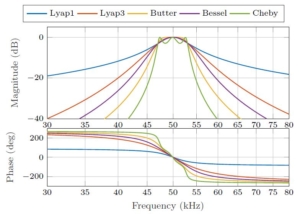
M. R. P. Ragazzon; S. Messineo; J. T. Gravdahl; D. M. Harcombe; M. G. Ruppert
Generalized Lyapunov Demodulator for Amplitude and Phase Estimation by the Internal Model Principle Proceedings Article
In: 8th IFAC Symposium on Mechatronic Systems, 2019, (accepted for publication).
@inproceedings{Ragazzon2019,
title = {Generalized Lyapunov Demodulator for Amplitude and Phase Estimation by the Internal Model Principle},
author = {M. R. P. Ragazzon and S. Messineo and J. T. Gravdahl and D. M. Harcombe and M. G. Ruppert},
year = {2019},
date = {2019-09-04},
booktitle = {8th IFAC Symposium on Mechatronic Systems},
abstract = {Effective demodulation of amplitude and phase is a requirement in a wide array of applications. Recent efforts have increased the demodulation performance, in particular, the Lyapunov demodulator allows bandwidths up to the carrier frequency of the signal. However, being inherently restricted to a single order filtering of the input signal, signal components outside its passband are not sufficiently attenuated for all applications, such as in multifrequency atomic force microscopy. In this article, the structure of the Lyapunov demodulator is transformed to an equivalent form, taking advantage of the internal model representation of the sinusoid to be tracked. A generalization of this formulation allows the application of standard filtering techniques in order to shape the characteristics of the demodulator, while retaining the perfect tracking condition provided by the internal model. Guidelines for the filter design are provided in order to achieve the desired characteristics, such as filtering order, tracking bandwidth, and transient performance. The resulting generalized Lyapunov demodulator structure is highly flexible, allows for direct employment of any standard filter type, is computationally simple, and easy to implement requiring only a bandpass filter, a single integrator, and two nonlinear transformations. Numerical results demonstrate the effectiveness of the approach, and provide a comparison of the various filters considered.},
note = {accepted for publication},
keywords = {},
pubstate = {published},
tppubtype = {inproceedings}
}
L. McCourt; B. S. Routley; M. G. Ruppert; A. J. Fleming
Resolution and Enhancement of Probes for Tip Enhanced Raman Spectroscopy Conference
International Conference on Nanophotonics and Micro/Nano Optics (NANOP), Munich, Germany, 2019.
@conference{McCourt2019,
title = {Resolution and Enhancement of Probes for Tip Enhanced Raman Spectroscopy},
author = {L. McCourt and B. S. Routley and M. G. Ruppert and A. J. Fleming},
year = {2019},
date = {2019-09-04},
booktitle = {International Conference on Nanophotonics and Micro/Nano Optics (NANOP)},
journal = {International Conference Nanophotonics and Micro/Nano Optics},
address = {Munich, Germany},
abstract = {Two photon apertureless nearfield lithography allows sub diffraction limited features for integrated circuit production. It involves exciting surface plasmons on a metallic atomic force microscopy probe, which generates an enhancement of the localised electric field, exposing a photoresist. Costing less than extreme ultra violet lithography, and reducing exposure from scattered light compared to one photon nearfield lithography, this technique is suited for device prototyping or low volume production. The work here considers the material and geometry of an ideal AFM probe in terms of resolution (producing the smallest features) and electric field enhancement.},
keywords = {},
pubstate = {published},
tppubtype = {conference}
}
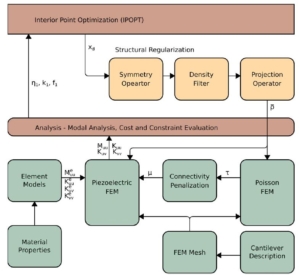
S. I. Moore; M. G. Ruppert; Y. K. Yong
An optimization framework for the design of piezoelectric AFM cantilevers Journal Article
In: Precision Engineering, vol. 60, pp. 130-142, 2019, (This work was supported by the Australian Research Council Discovery Project DP170101813).
@article{Moore2019c,
title = {An optimization framework for the design of piezoelectric AFM cantilevers},
author = {S. I. Moore and M. G. Ruppert and Y. K. Yong},
url = {https://www.sciencedirect.com/science/article/pii/S0141635919302260},
year = {2019},
date = {2019-08-15},
urldate = {2019-08-15},
journal = {Precision Engineering},
volume = {60},
pages = {130-142},
abstract = {To facilitate further miniaturization of atomic force microscopy (AFM) cantilevers and to eliminate the standard optical beam deflection sensor, integrated piezoelectric actuation and sensing on the chip level is a promising option. This article presents a topology optimization method for dynamic mode AFM cantilevers that maximizes the sensitivity of an integrated piezoelectric sensor under stiffness and resonance frequency constraints. Included in the formulation is a new material model C-SIMP (connectivity and solid isotropic material with penalization) that extends the SIMP model to explicitly include the penalization of unconnected structures. Example cantilever designs demonstrate the potential of the topology optimization method. The results show, firstly, the C-SIMP material model significantly reduces connectivity issues and, secondly, arbitrary cantilever topologies can produce increases in sensor sensitivity or resonance frequency compared to a rectangular topology.},
note = {This work was supported by the Australian Research Council Discovery Project DP170101813},
keywords = {},
pubstate = {published},
tppubtype = {article}
}
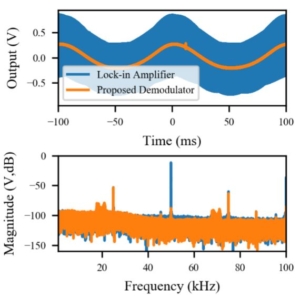
S. I. Moore; M. G. Ruppert; D. M. Harcombe; A. J. Fleming; Y. K. Yong
Design and Analysis of Low-Distortion Demodulators for Modulated Sensors Journal Article
In: IEEE/ASME Transactions on Mechatronics, vol. 24, no. 4, pp. 1861-1870, 2019, ISSN: 10834435, (This work was supported by the Australian Research Council Discovery Project DP170101813).
@article{Moore2019,
title = {Design and Analysis of Low-Distortion Demodulators for Modulated Sensors},
author = { S. I. Moore and M. G. Ruppert and D. M. Harcombe and A. J. Fleming and Y. K. Yong },
url = {https://www.precisionmechatronicslab.com/wp-content/uploads/2020/05/J19d-reduced.pdf},
doi = {10.1109/TMECH.2019.2928592},
issn = {10834435},
year = {2019},
date = {2019-07-17},
urldate = {2019-07-17},
journal = {IEEE/ASME Transactions on Mechatronics},
volume = {24},
number = {4},
pages = {1861-1870},
abstract = {System-based demodulators in the form of a Kalman and Lyapunov filter have been demonstrated to significantly outperform traditional demodulators, such as the lock-in amplifier, in bandwidth sensitive applications, for example high-speed atomic force microscopy. Building on their closed loop architecture, this article describes a broader class of high-speed closed-loop demodulators. The generic structure provides greater flexibility to independently control the bandwidth and sensitivity to out-of-band frequencies. A linear time-invariant description is derived which allows the utilization of linear control theory to design the demodulator. Experimental results on a nanopositioner with capacitive sensors demonstrate the realization of arbitrary demodulator dynamics while achieving excellent noise rejection.},
note = {This work was supported by the Australian Research Council Discovery Project DP170101813},
keywords = {},
pubstate = {published},
tppubtype = {article}
}
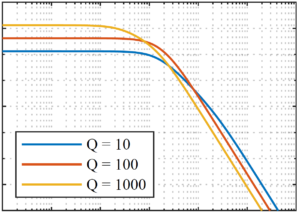
D. M. Harcombe; M. G. Ruppert; A. J. Fleming
Modeling and Noise Analysis of a Microcantilever-based Mass Sensor Proceedings Article
In: Int. Conference on Manipulation, Automation and Robotics at Small Scales (MARSS), Helsinki, Finland, 2019, ISSN: 978-1-7281-0948-0.
@inproceedings{Harcombe2019,
title = {Modeling and Noise Analysis of a Microcantilever-based Mass Sensor},
author = {D. M. Harcombe and M. G. Ruppert and A. J. Fleming},
url = {https://www.precisionmechatronicslab.com/wp-content/uploads/2021/02/C19c.pdf},
doi = {10.1109/MARSS.2019.8860982},
issn = {978-1-7281-0948-0},
year = {2019},
date = {2019-07-01},
booktitle = {Int. Conference on Manipulation, Automation and Robotics at Small Scales (MARSS)},
address = {Helsinki, Finland},
abstract = {Nanomechanical devices have the potential for practical applications as mass sensors. In microcantilever based sensing, resonance frequency shifts are tracked by a
phase-locked loop (PLL) in-order to monitor mass adsorption. A major challenge in minimizing the mass detection limit comes from the noise present in the system due to thermal, sensor and oscillator noise. There is numerical difficulty in simulating PLLs, as both low frequency phase estimates and high frequency mixing products need to be captured resulting in a stiff problem. By using linear system-theoretic modeling an in-depth analysis of the system is able to be conducted overcoming this issue. This provides insight into individual noise source propagation, dominant noise sources and possible ways to reduce their effects. The developed model is verified in simulation against the non-linear PLL, with each achieving low picogram sensitivity for a 100 Hz loop bandwidth and realistically modeled noise sources.},
keywords = {},
pubstate = {published},
tppubtype = {inproceedings}
}
phase-locked loop (PLL) in-order to monitor mass adsorption. A major challenge in minimizing the mass detection limit comes from the noise present in the system due to thermal, sensor and oscillator noise. There is numerical difficulty in simulating PLLs, as both low frequency phase estimates and high frequency mixing products need to be captured resulting in a stiff problem. By using linear system-theoretic modeling an in-depth analysis of the system is able to be conducted overcoming this issue. This provides insight into individual noise source propagation, dominant noise sources and possible ways to reduce their effects. The developed model is verified in simulation against the non-linear PLL, with each achieving low picogram sensitivity for a 100 Hz loop bandwidth and realistically modeled noise sources.
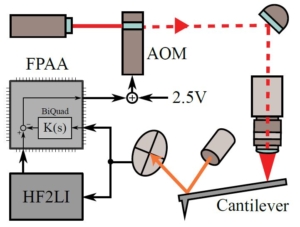
M. G. Ruppert; B. S. Routley; A. J. Fleming; Y. K. Yong; G. E. Fantner
Model-based Q Factor Control for Photothermally Excited Microcantilevers Proceedings Article
In: Int. Conference on Manipulation, Automation and Robotics at Small Scales (MARSS), Helsinki, Finland, 2019, ISSN: 978-1-7281-0948-0, (This work was supported by the Australian Research Council Discovery Project DP170101813).
@inproceedings{Ruppert2019,
title = {Model-based Q Factor Control for Photothermally Excited Microcantilevers},
author = {M. G. Ruppert and B. S. Routley and A. J. Fleming and Y. K. Yong and G. E. Fantner},
url = {https://www.precisionmechatronicslab.com/wp-content/uploads/2021/02/C19b.pdf},
doi = {10.1109/MARSS.2019.8860969},
issn = {978-1-7281-0948-0},
year = {2019},
date = {2019-07-01},
urldate = {2019-07-01},
booktitle = {Int. Conference on Manipulation, Automation and Robotics at Small Scales (MARSS)},
address = {Helsinki, Finland},
abstract = {Photothermal excitation of the cantilever for dynamic atomic force microscopy (AFM) modes is an attractive actuation method as it provides clean cantilever actuation leading to well-defined frequency responses. Unlike conventional piezo-acoustic excitation of the cantilever, it allows for model-based quality (Q) factor control in order to increase the cantilever tracking bandwidth for tapping-mode AFM or to reduce resonant ringing for high-speed photothermal offresonance tapping (PORT) in ambient conditions. In this work, we present system identification, controller design and experimental results on controlling the Q factor of a photothermally driven cantilever. The work is expected to lay the groundwork for future implementations for high-speed PORT imaging in ambient conditions.},
note = {This work was supported by the Australian Research Council Discovery Project DP170101813},
keywords = {},
pubstate = {published},
tppubtype = {inproceedings}
}
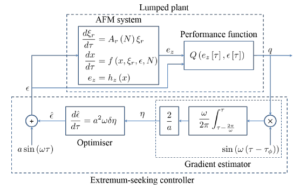
K. Wang; M. G. Ruppert; C. Manzie; D. Nesic; Y. K. Yong
Adaptive Scan for Atomic Force Microscopy Based on Online Optimisation: Theory and Experiment Journal Article
In: IEEE Transactions on Control System Technology, 2019, (accepted for publication).
@article{Wang2019,
title = {Adaptive Scan for Atomic Force Microscopy Based on Online Optimisation: Theory and Experiment},
author = {K. Wang and M. G. Ruppert and C. Manzie and D. Nesic and Y. K. Yong},
url = {https://ieeexplore.ieee.org/document/8643730},
year = {2019},
date = {2019-01-31},
journal = {IEEE Transactions on Control System Technology},
abstract = {A major challenge in Atomic Force Microscopy
(AFM) is to reduce the scan duration while retaining the
image quality. Conventionally, the scan rate is restricted to a
sufficiently small value in order to ensure a desirable image
quality as well as a safe tip-sample contact force. This usually
results in a conservative scan rate for samples that have a
large variation in aspect ratio and/or for scan patterns that
have a varying linear velocity. In this paper, an adaptive scan
scheme is proposed to alleviate this problem. A scan line-based
performance metric balancing both imaging speed and accuracy
is proposed, and the scan rate is adapted such that the metric
is optimised online in the presence of aspect ratio and/or linear
velocity variations. The online optimisation is achieved using an
extremum-seeking (ES) approach, and a semi-global practical
asymptotic stability (SGPAS) result is shown for the overall
system. Finally, the proposed scheme is demonstrated via both
simulation and experiment.},
note = {accepted for publication},
keywords = {},
pubstate = {published},
tppubtype = {article}
}
(AFM) is to reduce the scan duration while retaining the
image quality. Conventionally, the scan rate is restricted to a
sufficiently small value in order to ensure a desirable image
quality as well as a safe tip-sample contact force. This usually
results in a conservative scan rate for samples that have a
large variation in aspect ratio and/or for scan patterns that
have a varying linear velocity. In this paper, an adaptive scan
scheme is proposed to alleviate this problem. A scan line-based
performance metric balancing both imaging speed and accuracy
is proposed, and the scan rate is adapted such that the metric
is optimised online in the presence of aspect ratio and/or linear
velocity variations. The online optimisation is achieved using an
extremum-seeking (ES) approach, and a semi-global practical
asymptotic stability (SGPAS) result is shown for the overall
system. Finally, the proposed scheme is demonstrated via both
simulation and experiment.
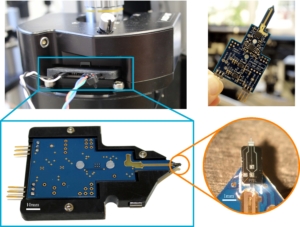
M. G. Ruppert; S. I. Moore; M. Zawierta; A. J. Fleming; G. Putrino; Y. K. Yong
Multimodal atomic force microscopy with optimized higher eigenmode sensitivity using on-chip piezoelectric actuation and sensing Journal Article
In: Nanotechnology, vol. 30, no. 8, pp. 085503, 2019, (This work was supported by the Australian Research Council Discovery Project DP170101813).
@article{Ruppert2018b,
title = {Multimodal atomic force microscopy with optimized higher eigenmode sensitivity using on-chip piezoelectric actuation and sensing},
author = {M. G. Ruppert and S. I. Moore and M. Zawierta and A. J. Fleming and G. Putrino and Y. K. Yong},
url = {https://www.precisionmechatronicslab.com/wp-content/uploads/2019/08/Ruppert_2019_Nanotechnology_30_085503.pdf},
doi = {https://doi.org/10.1088/1361-6528/aae40b},
year = {2019},
date = {2019-01-02},
urldate = {2019-01-02},
journal = {Nanotechnology},
volume = {30},
number = {8},
pages = {085503},
abstract = {Atomic force microscope (AFM) cantilevers with integrated actuation and sensing provide several distinct advantages over conventional cantilever instrumentation. These include clean frequency responses, the possibility of down-scaling and parallelization to cantilever arrays as well as the absence of optical interference. While cantilever microfabrication technology has continuously advanced over the years, the overall design has remained largely unchanged; a passive rectangular shaped cantilever design has been adopted as the industry wide standard. In this article, we demonstrate multimode AFM imaging on higher eigenmodes as well as bimodal AFM imaging with cantilevers using fully integrated piezoelectric actuation and sensing. The cantilever design maximizes the higher eigenmode deflection sensitivity by optimizing the transducer layout according to the strain mode shape. Without the need for feedthrough cancellation, the read-out method achieves close to zero actuator/sensor feedthrough and the sensitivity is sufficient to resolve the cantilever Brownian motion.},
note = {This work was supported by the Australian Research Council Discovery Project DP170101813},
keywords = {},
pubstate = {published},
tppubtype = {article}
}
2018
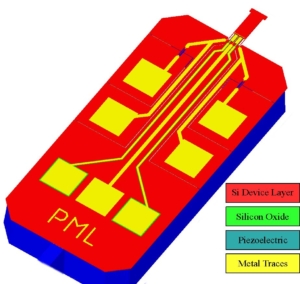
M. G. Ruppert; Y. K. Yong
Design of Hybrid Piezoelectric/Piezoresistive Cantilevers for Dynamic-mode Atomic Force Microscopy Proceedings Article
In: IEEE/ASME Advanced Intelligent Mechatronics (AIM), Auckland, New Zealand, 2018, (This work was supported by the Australian Research Council Discovery Project DP170101813).
@inproceedings{Ruppert2018b,
title = {Design of Hybrid Piezoelectric/Piezoresistive Cantilevers for Dynamic-mode Atomic Force Microscopy},
author = {M. G. Ruppert and Y. K. Yong},
year = {2018},
date = {2018-07-09},
urldate = {2018-07-09},
booktitle = {IEEE/ASME Advanced Intelligent Mechatronics (AIM)},
address = {Auckland, New Zealand},
abstract = {Atomic force microscope cantilevers with integrated actuation and sensing on the chip level provide several distinct advantages over conventional cantilever instrumentation. These include clean frequency responses, the possibility of down-scaling and parallelization to cantilever arrays as well as the absence of optical interferences. However, the two major difficulties with integrated transduction methods are a complicated fabrication process, often involving a number of fabrication
steps, and a high amount of feedthrough from actuation to sensing electrodes. This work proposes two hybrid cantilever designs with piezoelectric actuators and piezoresistive sensors to reduce the actuator to sensor feedthrough. The designs can be realized using a commercial microelectromechanical systems fabrication process and only require a simple five-mask patterning and etching process. Finite element analysis results are presented to obtain modal responses, actuator gain and sensor sensitivities of the cantilever designs.},
note = {This work was supported by the Australian Research Council Discovery Project DP170101813},
keywords = {},
pubstate = {published},
tppubtype = {inproceedings}
}
steps, and a high amount of feedthrough from actuation to sensing electrodes. This work proposes two hybrid cantilever designs with piezoelectric actuators and piezoresistive sensors to reduce the actuator to sensor feedthrough. The designs can be realized using a commercial microelectromechanical systems fabrication process and only require a simple five-mask patterning and etching process. Finite element analysis results are presented to obtain modal responses, actuator gain and sensor sensitivities of the cantilever designs.
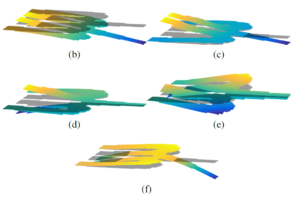
S. I. Moore; M. G. Ruppert; Y. K. Yong
Arbitrary placement of AFM cantilever higher eigenmodes using structural optimization Proceedings Article
In: International Conference on Manipulation, Automation and Robotics at Small Scales (MARSS), 2018, (This work was supported by the Australian Research Council Discovery Project DP170101813).
@inproceedings{Moore2018,
title = {Arbitrary placement of AFM cantilever higher eigenmodes using structural optimization},
author = {S. I. Moore and M. G. Ruppert and Y. K. Yong},
year = {2018},
date = {2018-07-04},
urldate = {2018-07-04},
booktitle = {International Conference on Manipulation, Automation and Robotics at Small Scales (MARSS)},
journal = {International Conference on Manipulation, Automation and Robotics at Small Scales (MARSS)},
abstract = {This article presents a novel cantilever design approach to place higher mode frequencies within a specific frequency band to alleviate instrumentation and Q control feasibility. This work is motivated by the emerging field of multifrequency atomic force microscopy (AFM) which involves the excitation and/or detection of several cantilever modes at once. Unlike other operating modes, multifrequency AFM allows the tracking of the sample topography on the fundamental mode while simultaneously acquiring complimentary nanomechanical information on a higher mode. However, higher modes of conventional rectangular tapping-mode cantilevers are usually in the MHz regime and therefore impose severe restrictions on the direct controllability of these modes. To overcome this limitation, an optimization technique is employed which is capable of placing the first five modes within a 200 kHz bandwidth.},
note = {This work was supported by the Australian Research Council Discovery Project DP170101813},
keywords = {},
pubstate = {published},
tppubtype = {inproceedings}
}
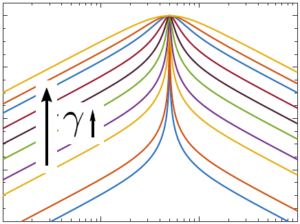
M. G. Ruppert; D. M. Harcombe; S. I. Moore; A. J. Fleming
Direct Design of Closed-loop Demodulators for Amplitude Modulation Atomic Force Microscopy Proceedings Article
In: American Control Conference, Milwaukee, WI, 2018.
@inproceedings{C18b,
title = {Direct Design of Closed-loop Demodulators for Amplitude Modulation Atomic Force Microscopy},
author = {M. G. Ruppert and D. M. Harcombe and S. I. Moore and A. J. Fleming},
url = {https://www.precisionmechatronicslab.com/wp-content/uploads/2021/02/C18b.pdf},
doi = {10.23919/ACC.2018.8430896},
year = {2018},
date = {2018-06-27},
booktitle = {American Control Conference},
address = {Milwaukee, WI},
abstract = {A fundamental component of the z-axis feedback loop in amplitude modulation atomic force microscopy is the demodulator. It dictates both bandwidth and noise in the amplitude and phase estimate of the cantilever deflection signal. In this paper, we derive a linear time-invariant model of a closedloop demodulator with user definable tracking bandwidth and sensitivity to other frequency components. A direct demodulator design method is proposed based on the reformulation of the Lyapunov filter as a modulated-demodulated controller in closed loop with a unity plant. Simulation and experimental results for a higher order Lyapunov filter as well as Butterworth and Chebyshev type demodulators are presented.},
keywords = {},
pubstate = {published},
tppubtype = {inproceedings}
}

M. G. Ruppert
Self-sensing, estimation and control in multifrequency Atomic Force Microscopy. Journal Article
In: Journal & Proceedings of the Royal Society of New South Wales, vol. 151, no. 1, pp. 111, 2018, ISSN: 0035-9173/18/010111-01.
@article{Ruppert2018b,
title = {Self-sensing, estimation and control in multifrequency Atomic Force Microscopy. },
author = {M. G. Ruppert},
url = {https://royalsoc.org.au/images/pdf/journal/151-1-Ruppert.pdf},
issn = {0035-9173/18/010111-01},
year = {2018},
date = {2018-06-01},
journal = {Journal & Proceedings of the Royal Society of New South Wales},
volume = {151},
number = {1},
pages = {111},
abstract = {Despite the undeniable success of the atomic force microscope (AFM), dynamic techniques still face limitations in terms of spatial resolution, imaging speed and high cost of acquisition. In order to expand the capabilities of the instrument, it was realized that the information about the nano-mechanical properties of a sample are encoded over a range of frequencies and the excitation and detection of higher-order eigenmodes of the micro-cantilever open up further informa-
tion channels. The ability to control these modes and their fast responses to excitation is believed to be the key to unravelling the true potential of these ethods. This work addresses three major drawbacks of the standard AFM setup, which limit the feasibility of multi-frequency approaches.
First, microelectromechanical system (MEMS) probes with integrated piezoelectric layers is motivated, enabling the development of novel multimode self-sensing and self-actuating techniques. Specifically, these piezoelectric transduction schemes permit the miniaturization of the entire AFM towards a cost-effective single-chip device with nanoscale precision in a much smaller form factor than that of conventional macroscale instruments.
Second, the integrated actuation enables the development of multimode controllers which exhibits remarkable performance in arbitrarily modifying the quality factor of multiple eigenmodes and comes with inherent stability robustness. The experimental results demonstrate improved imaging stability, higher scan speeds and adjustable contrast when mapping nano-mechanical properties of soft samples.
Last, in light of the demand for constantly increasing imaging speeds while providing multi-frequency flexibility, the estimation of multiple components of the high-frequency deflection signal is performed with a linear time-varying multi-frequency Kalman filter. The chosen representation allows for an efficient high-bandwidth implementation on a Field Programmable Gate Array. Tracking bandwidth, noise performance and trimodal AFM imaging on a two-component polymer sample are verified and shown to be superior to that of the commonly used lock-in amplifier.},
keywords = {},
pubstate = {published},
tppubtype = {article}
}
tion channels. The ability to control these modes and their fast responses to excitation is believed to be the key to unravelling the true potential of these ethods. This work addresses three major drawbacks of the standard AFM setup, which limit the feasibility of multi-frequency approaches.
First, microelectromechanical system (MEMS) probes with integrated piezoelectric layers is motivated, enabling the development of novel multimode self-sensing and self-actuating techniques. Specifically, these piezoelectric transduction schemes permit the miniaturization of the entire AFM towards a cost-effective single-chip device with nanoscale precision in a much smaller form factor than that of conventional macroscale instruments.
Second, the integrated actuation enables the development of multimode controllers which exhibits remarkable performance in arbitrarily modifying the quality factor of multiple eigenmodes and comes with inherent stability robustness. The experimental results demonstrate improved imaging stability, higher scan speeds and adjustable contrast when mapping nano-mechanical properties of soft samples.
Last, in light of the demand for constantly increasing imaging speeds while providing multi-frequency flexibility, the estimation of multiple components of the high-frequency deflection signal is performed with a linear time-varying multi-frequency Kalman filter. The chosen representation allows for an efficient high-bandwidth implementation on a Field Programmable Gate Array. Tracking bandwidth, noise performance and trimodal AFM imaging on a two-component polymer sample are verified and shown to be superior to that of the commonly used lock-in amplifier.
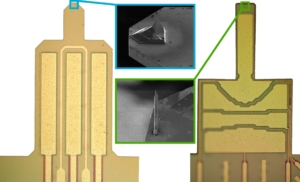
M. G. Ruppert; S. I. Moore; M. Zawierta; G. Putrino; Y. K. Yong
Advanced Sensing and Control with Active Cantilevers for Multimodal Atomic Force Microscopy Conference
7th Multifrequency AFM Conference, Madrid, Spain, 2018, (This work was supported by the Australian Research Council Discovery Project DP170101813).
@conference{Ruppert2018,
title = {Advanced Sensing and Control with Active Cantilevers for Multimodal Atomic Force Microscopy},
author = {M. G. Ruppert and S. I. Moore and M. Zawierta and G. Putrino and Y. K. Yong},
year = {2018},
date = {2018-04-18},
urldate = {2018-04-18},
booktitle = {7th Multifrequency AFM Conference},
address = {Madrid, Spain},
abstract = {Atomic force microscopy (AFM) cantilevers with integrated actuation and sensing on the chip level provide several distinct advantages over conventional cantilever instrumentation. These include clean frequency responses, the possibility of down-scaling and parallelization to cantilever arrays as well as the absence of optical interferences. While cantilever microfabrication technology has continuously advanced over the years, the overall design has remained largely unchanged; a passive rectangular shaped cantilever design has been adopted as the industry wide standard. Consequently, conventional cantilever instrumentation requires external piezo acoustic excitation as well as an external optical deflection sensor. Both of these components are not optimal for current trends in multifrequency AFM technology which revolve around further down-sizing, parallelization and measurements at multiple higher eigenmodes. Using microelectromechanical systems (MEMS) fabrication processes, this work aims to optimize cantilever instrumentation by realizing a new class of probes with high-performance integrated actuators and sensors. Equipped with multiple integrated piezoelectric layers for both actuation and sensing, these cantilevers are capable of achieving an increased higher eigenmode sensitivity and/or guaranteed collocated system properties compared to commercially available counterparts; examples of such designs are shown in Figure 1. The geometry as well as the integrated actuator/sensor arrangement is optimized using finite element modelling with individual design goals. The designs are realized using a commercial MEMS fabrication process and only require a simple five-mask patterning and etching process and post-fabricated sharp tips.},
note = {This work was supported by the Australian Research Council Discovery Project DP170101813},
keywords = {},
pubstate = {published},
tppubtype = {conference}
}
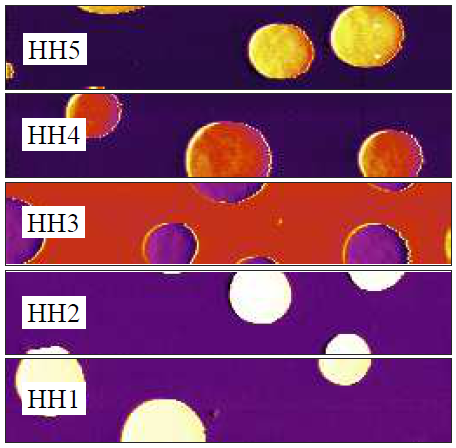
D. M. Harcombe; M. G. Ruppert; M. R. P. Ragazzon; A. J. Fleming
Lyapunov Estimation for High-Speed Demodulation in Multifrequency Atomic Force Microscopy Journal Article
In: Beilstein Journal of Nanotechnology, vol. 9, pp. 490-498, 2018, ISSN: 21904286.
@article{J18c,
title = {Lyapunov Estimation for High-Speed Demodulation in Multifrequency Atomic Force Microscopy},
author = {D. M. Harcombe and M. G. Ruppert and M. R. P. Ragazzon and A. J. Fleming},
url = {https://www.precisionmechatronicslab.com/wp-content/uploads/2018/02/J18c.pdf},
doi = {10.3762/bjnano.9.47},
issn = {21904286},
year = {2018},
date = {2018-02-28},
journal = {Beilstein Journal of Nanotechnology},
volume = {9},
pages = {490-498},
abstract = {An important issue in the emerging field of multifrequency atomic force microscopy (MF-AFM) is the accurate and fast demodulation of the cantilever-tip deflection signal. As this signal consists of multiple frequency components and noise processes, a lock-in amplifier is typically employed for its narrowband response. However, this demodulator suffers inherent bandwidth limitations as high frequency mixing products must be filtered out and several must be operated in parallel. Many MF-AFM methods require amplitude and phase demodulation at multiple frequencies of interest, enabling both z-axis feedback and phase contrast imaging to be achieved. This article proposes a model-based multifrequency Lyapunov filter implemented on a Field Programmable Gate Array (FPGA) for high-speed MF-AFM demodulation. System descriptions and simulations are verified by experimental results demonstrating high tracking bandwidths, strong off-mode rejection and minor sensitivity to cross-coupling effects. Additionally, a five-frequency system operating at 3.5MHz is implemented for higher harmonic amplitude and phase imaging up to 1MHz.},
keywords = {},
pubstate = {published},
tppubtype = {article}
}
2017
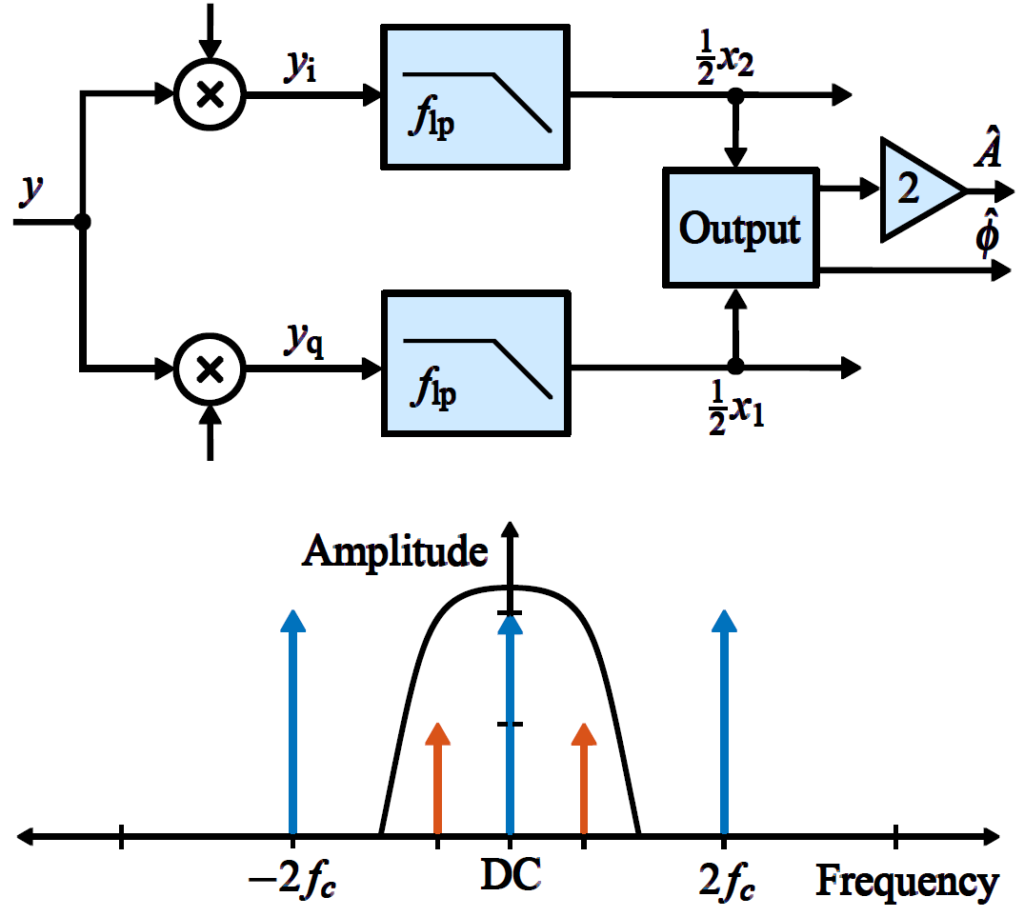
M. G. Ruppert; D. M. Harcombe; M. R. P. Ragazzon; S. O. R. Moheimani; A. J. Fleming
A Review of Demodulation Techniques for Amplitude Modulation Atomic Force Microscopy Journal Article
In: Bellstein Journal of Nanotechnology, vol. 8, pp. 1407–1426, 2017.
@article{J17h,
title = {A Review of Demodulation Techniques for Amplitude Modulation Atomic Force Microscopy},
author = {M. G. Ruppert and D. M. Harcombe and M. R. P. Ragazzon and S. O. R. Moheimani and A. J. Fleming},
url = {https://www.precisionmechatronicslab.com/wp-content/uploads/2020/08/2190-4286-8-142.pdf},
doi = {10.3762/bjnano.8.142},
year = {2017},
date = {2017-09-01},
journal = {Bellstein Journal of Nanotechnology},
volume = {8},
pages = {1407–1426},
abstract = {In this review paper, traditional and novel demodulation methods applicable to amplitude modulation atomic force microscopy are implemented on a widely used digital processing system. As a crucial bandwidth-limiting component in the z-axis feedback loop of an atomic force microscope, the purpose of the demodulator is to obtain estimates of amplitude and phase of the cantilever deflection signal in the presence of sensor noise or additional distinct frequency components. Specifically for modern multifrequency techniques, where higher harmonic and/or higher eigenmode contributions are present in the oscillation signal, the fidelity of the estimates obtained from some demodulation techniques is not guaranteed. To enable a rigorous comparison, the performance metrics tracking bandwidth, implementation complexity and sensitivity to other frequency components are experimentally evaluated for each method. Finally, the significance of an adequate demodulator bandwidth is highlighted during high-speed tapping-mode AFM experiments in constant height mode.},
keywords = {},
pubstate = {published},
tppubtype = {article}
}
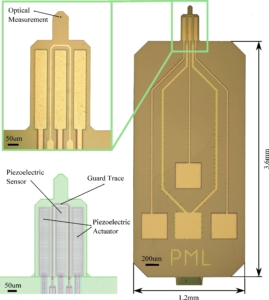
M. G. Ruppert; Y. K. Yong
Note: Guaranteed collocated multimode control of an atomic force microscope cantilever using on-chip piezoelectric actuation and sensing Journal Article
In: Review of Scientific Instruments, vol. 88, no. 086109, 2017, (This work was supported by the Australian Research Council Discovery Project DP170101813).
@article{Ruppert2017b,
title = {Note: Guaranteed collocated multimode control of an atomic force microscope cantilever using on-chip piezoelectric actuation and sensing},
author = {M. G. Ruppert and Y. K. Yong},
url = {https://www.precisionmechatronicslab.com/wp-content/uploads/2017/08/2017_JNote_RSI_Vol88_086109-2.pdf},
doi = {10.1063/1.4990451},
year = {2017},
date = {2017-08-15},
urldate = {2017-08-15},
journal = {Review of Scientific Instruments},
volume = {88},
number = {086109},
abstract = {The quality (Q) factor is an important parameter of the resonance of the microcantilever as it determines
both imaging bandwidth and force sensitivity. The ability to control the Q factor of multiple
modes is believed to be of great benefit for atomic force microscopy techniques involving multiple
eigenmodes. In this paper, we propose a novel cantilever design employing multiple piezoelectric
transducers which are used for separated actuation and sensing, leading to guaranteed collocation
of the first eight eigenmodes up to 3 MHz. The design minimizes the feedthrough usually observed
with these systems by incorporating a guard trace on the cantilever chip. As a result, a multimode
Q controller is demonstrated to be able to modify the quality factor of the first two eigenmodes over
up to four orders of magnitude without sacrificing robust stability.},
note = {This work was supported by the Australian Research Council Discovery Project DP170101813},
keywords = {},
pubstate = {published},
tppubtype = {article}
}
both imaging bandwidth and force sensitivity. The ability to control the Q factor of multiple
modes is believed to be of great benefit for atomic force microscopy techniques involving multiple
eigenmodes. In this paper, we propose a novel cantilever design employing multiple piezoelectric
transducers which are used for separated actuation and sensing, leading to guaranteed collocation
of the first eight eigenmodes up to 3 MHz. The design minimizes the feedthrough usually observed
with these systems by incorporating a guard trace on the cantilever chip. As a result, a multimode
Q controller is demonstrated to be able to modify the quality factor of the first two eigenmodes over
up to four orders of magnitude without sacrificing robust stability.
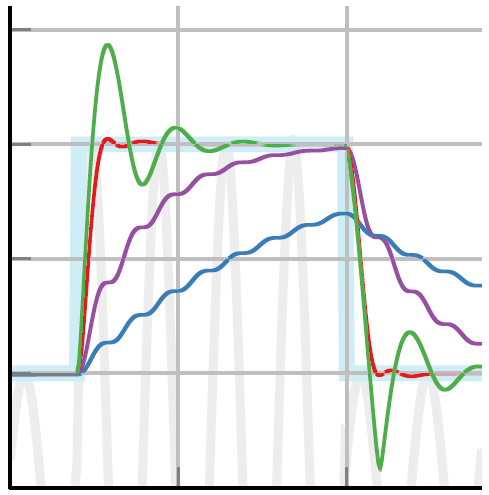
M. R. P. Ragazzon; M. G. Ruppert; D. M. Harcombe; A. J. Fleming; J. T. Gravdahl
Lyapunov Estimator for High-Speed Demodulation in Dynamic Mode Atomic Force Microscopy Journal Article
In: IEEE Transactions on Control Systems Technology, vol. 26, no. 2, pp. 765-772, 2017.
@article{J17e,
title = {Lyapunov Estimator for High-Speed Demodulation in Dynamic Mode Atomic Force Microscopy},
author = {M. R. P. Ragazzon and M. G. Ruppert and D. M. Harcombe and A. J. Fleming and J. T. Gravdahl},
url = {https://www.precisionmechatronicslab.com/wp-content/uploads/2017/09/J17e.pdf},
year = {2017},
date = {2017-08-01},
journal = {IEEE Transactions on Control Systems Technology},
volume = {26},
number = {2},
pages = {765-772},
abstract = {In dynamic mode atomic force microscopy (AFM), the imaging bandwidth is governed by the slowest component in the open-loop chain consisting of the vertical actuator, cantilever and demodulator. While the common demodulation method is to use a lock-in amplifier (LIA), its performance is ultimately bounded by the bandwidth of the post-mixing low-pass filters. This article proposes an amplitude and phase estimation method based on a strictly positive real Lyapunov design approach. The estimator is designed to be of low complexity while allowing for high bandwidth. Additionally, suitable gains for high performance are suggested such that no tuning is necessary. The Lyapunov estimator is experimentally implemented for amplitude demodulation and shown to surpass the LIA in terms of tracking bandwidth and noise performance. High-speed AFM images are presented to corroborate the results.},
keywords = {},
pubstate = {published},
tppubtype = {article}
}
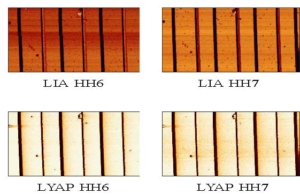
D. M. Harcombe; M. G. Ruppert; A. J. Fleming
Higher-harmonic AFM Imaging with a High-Bandwidth Multifrequency Lyapunov Filter Proceedings Article
In: IEEE/ASME Advanced Intelligent Mechatronics (AIM), Munich, Germany, 2017.
@inproceedings{C17e,
title = {Higher-harmonic AFM Imaging with a High-Bandwidth Multifrequency Lyapunov Filter},
author = {D. M. Harcombe and M. G. Ruppert and A. J. Fleming},
year = {2017},
date = {2017-07-03},
booktitle = {IEEE/ASME Advanced Intelligent Mechatronics (AIM)},
address = {Munich, Germany},
abstract = {A major difficulty in multifrequency atomic force microscopy (MF-AFM) is the accurate estimation of amplitude and phase at multiple frequencies for both z-axis feedback and material contrast imaging. Typically a lock-in amplifier is chosen as it is both narrowband and simple to implement. However, it inherently suffers drawbacks including a limited bandwidth due to post mixing low-pass filters and the necessity for multiple to be operated in parallel for MF-AFM. This paper proposes a multifrequency demodulator in the form of a modelbased Lyapunov filter implemented on a Field Programmable Gate Array (FPGA). System modelling and simulations are verified by experimental results demonstrating high tracking bandwidth and off-mode rejection at modelled frequencies. Additionally, AFM scans with a five-frequency-based system are presented wherein higher harmonic imaging is performed up to 1 MHz.},
keywords = {},
pubstate = {published},
tppubtype = {inproceedings}
}
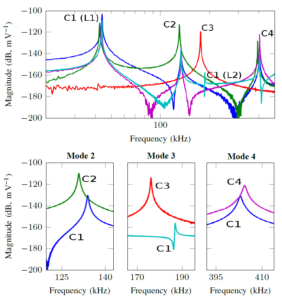
S. I. Moore; M. G. Ruppert; Y. K. Yong
Design and Analysis of Piezoelectric Cantilevers with Enhanced Higher Eigenmodes for Atomic Force Microscopy Proceedings Article
In: IEEE/ASME Advanced Intelligent Mechatronics (AIM), Munich, Germany, 2017, (This work was supported by the Australian Research Council Discovery Project DP170101813).
@inproceedings{Moore2017b,
title = {Design and Analysis of Piezoelectric Cantilevers with Enhanced Higher Eigenmodes for Atomic Force Microscopy},
author = {S. I. Moore and M. G. Ruppert and Y. K. Yong},
year = {2017},
date = {2017-07-02},
urldate = {2017-07-02},
booktitle = {IEEE/ASME Advanced Intelligent Mechatronics (AIM)},
address = {Munich, Germany},
abstract = {Atomic force microscope (AFM) cantilevers with
integrated actuation and sensing provide several distinct advantages
over conventional cantilever instrumentation such as
clean frequency responses, the possibility of down-scaling and
parallelization to cantilever arrays as well as the absence of optical
interferences. However, for multifrequency AFM techniques
involving higher eigenmodes of the cantilever, optimization
of the transducer location and layout has to be taken into
account. This work proposes multiple integrated piezoelectric
regions on the cantilever which maximize the deflection of the
cantilever and the piezoelectric charge response for a given
higher eigenmode based on the spatial strain distribution. Finite
element analysis is performed to find the optimal transducer
topology and experimental results are presented which highlight
an actuation gain improvement up to 42 dB on the third mode
and sensor sensitivity improvement up to 38 dB on the second
mode.},
note = {This work was supported by the Australian Research Council Discovery Project DP170101813},
keywords = {},
pubstate = {published},
tppubtype = {inproceedings}
}
integrated actuation and sensing provide several distinct advantages
over conventional cantilever instrumentation such as
clean frequency responses, the possibility of down-scaling and
parallelization to cantilever arrays as well as the absence of optical
interferences. However, for multifrequency AFM techniques
involving higher eigenmodes of the cantilever, optimization
of the transducer location and layout has to be taken into
account. This work proposes multiple integrated piezoelectric
regions on the cantilever which maximize the deflection of the
cantilever and the piezoelectric charge response for a given
higher eigenmode based on the spatial strain distribution. Finite
element analysis is performed to find the optimal transducer
topology and experimental results are presented which highlight
an actuation gain improvement up to 42 dB on the third mode
and sensor sensitivity improvement up to 38 dB on the second
mode.

